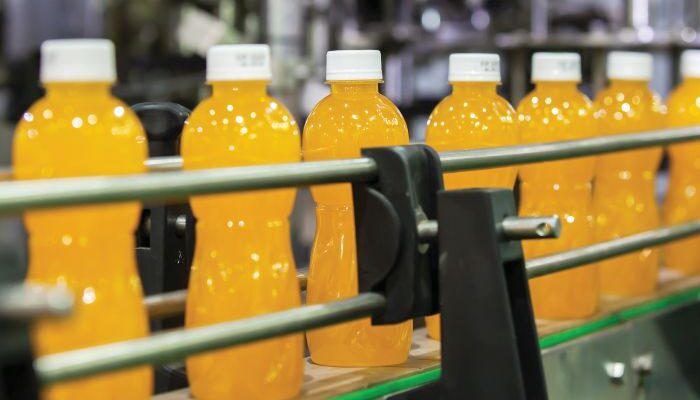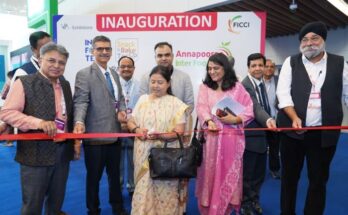Some Mega Food Parks have encouraged and even assisted farmers in their project clusters to experiment and diversify. Many farmers have taken up horticulture for two main reasons – surety of buyback and creation of farm-gate infrastructure such as packhouses and logistics support provided by the Mega Food Parks…
The food processing sector is regarded as the growth engine of the agriculture sector in India. It is thus correctly advocated that an efficient food processing sector, consistently growing at double-digit rates, is a must for the agriculture sector to grow at more than 4 per cent and serve the ever-increasing food requirements of the country’s growing population. Food processing is also essential to make the humungous efforts of India’s farmers in the face of many odds worthwhile.
It is now well-recognised by all stakeholders – governments, farmers and industry – that the fortunes of agriculture and food processing sectors are intertwined and an integrated approach is needed to address problems of food spoilage and wastage, food security, inflation and dwindling farm incomes. Various government policies of the past half a decade showcase this interdependence of food processing and agriculture.
The food production in the country is likely to double in the next decade or so. Yet at present, India accounts for less than 3 per cent of international food trade, and lack of processing facilities has been leading to wastage/value loss of about 35 per cent of the agricultural produce, worth 10 billion USD as per various estimates.
You may also like to read – How food processing industry is helping SMBs write their growth story
It is against this backdrop that a necessity was felt for an entity that would provide the crucial connectivity to bring together farmers, traders, industries and consumers. This need led to the launch of The Mega Food Parks Scheme (MFPS) in 2008-09, which is the flagship programme of the Ministry of Food Processing Industries (MoFPI), Government of India. MFPS is also the most crucial element of the Pradhan Mantri Kisan Sampada Yojana which embodies Prime Minister Narendra Modi’s vision of doubling farmers’ incomes.
The Mega Food Parks Scheme
The primary objective of Mega Food Parks is to provide state-of-the-art facilities for food processing along the value chain from the farm to the market. At its launch, the Scheme Guidelines struck all the right chords. They would adopt a cluster-based ‘hub and spoke model’, with due consideration given to backward (to be read as sourcing) and forward (to be read as marketing) linkages and they would help create modern infrastructure near the farm, and provide facilities for transportation, logistics and centralised processing centres (CPC) as well as farm-proximate primary processing centres (PPCs). A grant of up to Rs. 50 crores per project was to be provided by the Ministry of Food Processing Industries and it was envisaged that each Mega Food Park would be completed in 30 months – which, rightly so, proved to be an excessively idealistic target.
Like all large infrastructure development projects, things were slow to take off due to a variety of reasons such as time taken in land acquisition and CLU, financial closure, environmental approvals, unfavourable SPV structuring norms in the Scheme Guidelines, and in some cases unviable locations.
You may also like to read – More intelligent AI algorithms for the agriculture sector coming soon: Mohit Pande, CBO, CropIn
As a result, by 2015-16, the Scheme was written off by many; but the time of Mega Food Parks was still to come. The ministry too introduced two major initiatives to infuse fresh energy into the MFP Scheme –
- Setting up a food processing fund under NABARD for providing loans at concessional rates to food parks and units within the food parks
- Re-launch of the CEFPPC scheme with a grant-in-aid of up to Rs. 5 crores, with preference for food processing units established inside food parks.
Mega Food Parks Have Arrived
It would not be an understatement to say that the time of Mega Food Parks is now. The data over the last 3-4 years shows that things have gradually changed for the better, with more than 50 per cent of allotted Mega Food Parks having become operational and starting to attain gestation. Some data points given below illustrate the present status (as of April 2023) –
| Total Mega Food Parks | 41 |
| Operational Mega Food Parks | 24 |
| Mega Food Parks under various stages of implementation | 17 |
| Cumulative Project Cost | Rs. 4635.87 crores |
| Promoters’ contribution | Rs. 2664.74 crores |
| MoFPI Grant | Sanctioned Rs.1971.13 crores (Released: Rs. 1465.26 crores) |
There is also an accelerated growth of units being established in Mega Food Parks; and out of the 506 units approved by the MoFPI under its CEFPPC (Units) scheme as of January 2024, close to 150 food processing units are inside Mega Food Parks sanctioned by the ministry. Thus, the CEFPPC Scheme has provided the much-needed boost for bringing food processing units to the Mega Food Parks.
Role of Mega Food Parks in Transforming Indian Agriculture
The Mega Food Parks have started playing a significant role in giving a boost to the agribusiness sector and will continue to play an even more important role in the next 5-7 years. The examples are now evident and include:
- Patanjali’s journey to become an FMCG powerhouse started with its Patanjali Mega Food Park in Haridwar. Its food products revenue is going to touch USD 1 billion soon and it sources produce, directly and indirectly, from more than 10 lakh farmers. It has commercialised some seemingly irrelevant products such as buransh juice, helped increase farmer incomes and developed many local entrepreneurs.
- Gujarat Agro Infrastructure Mega Food Park has already secured an investment of more than Rs. 400 crores from processors against the ministry’s own goal of 250 crores per Mega Food Park in a tribal-dominated taluk. It is likely to attract a total investment of nearly Rs. 650 crores, with the related preservation and procurement of agricultural produce benefitting a huge number of farmers. Their fully operational storage facilities have supported scores of dairy farmers too, in addition to storage of other agricultural produce.
- Himalayan Mega Food Park is helping apple growers in Uttarakhand with its apple juice concentrate facility, and Cremica Food Park is changing the fortunes of tomato farmers in Himachal and surrounding areas with a world-class pulping facility.
You may also like to read – Need to make agricultural research demand driven with private sector engagement: Dr. Rajeev Varshney, Murdoch University
All operational food parks, including the examples above, are already sourcing a range of raw materials directly and indirectly from a minimum of about 5000-6000 farmers each. They are already contributing in a big way to reducing wastage of agri and horticulture produce, through more than 2.5 lakh MT capacity of modern cold and ambient warehousing that has been created in these projects. These storage facilities also provided logistical support and relief during the Covid lockdown as Mega Food Parks continued to operate and offer services.
With exports being the major market for processed foods, state-of-the-art processing infrastructure created at Mega Food Parks by promoters and unit owners is boosting exports of processed foods.
Some Mega Food Parks have encouraged and even assisted farmers in their project clusters to experiment and diversify. Many farmers have taken up horticulture for two main reasons – surety of buyback and creation of farm-gate infrastructure such as packhouses and logistics support provided by the Mega Food Parks. It has been seen in various locations that farmer producer organisations (FPOs), being promoted heavily by governments, have found a market for their produce in these mega food parks.
Various food parks have been established in the hilly states, tribal and difficult areas. This has not only helped the farmers of these regions become a part of mainstream agriculture but has also fostered entrepreneurship among locals and resulted in the overall economic development of the region.
You may also like to read: FarMart launches Saudabook tech solution for food processors in India
Mega Food Parks are also becoming job work hubs for many prominent Indian and global food brands and helping exports of food products to various parts of the world. Serving such markets and players requires quality and traceability across the entire supply chain. Some Mega Food Parks are actively working with farmers and training them too to ensure both.
When all 41 projects are complete and fully operational with their central facilities and food processing units, more than 15 lakh farmers in these project clusters would benefit. It is evident that such support through Mega Food Parks will enthuse many more farmers and FPOs to focus on better and processable produce and food parks are already playing and shall continue to play an important role in moulding the future of India’s agriculture sector.
In the post-Covid world, global food supply chains are undergoing major realignments. Given India’s inherent strengths and renewed focus from the government, India can emerge as a major global sourcing hub and also a major consumption market, thus creating a huge opportunity for Indian businesses and startups. Mega Food Parks will no doubt pave the way to transform the agriculture sector and unlock its real potential through processing and value addition.
(The article is co-authored by Ritwik Bahuguna, Managing Director, Farlense Group and Pranav Doshi, Managing Director, Gujarat Agro Infrastructure Mega Food Park. Views expressed in the article are authors’ own.)




